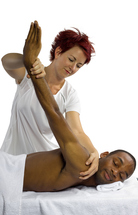Neuromuscular Re-Education
 Neuromuscular re-education is a mode of therapy used by chiropractors and physical therapists to assist in restoring normal movement after injury. Normally, muscles and nerves work together to produce movements. In fact, it is believed that nerves and muscles are so in tune that such collaborative patterns are reinforced over time, stored in the brain, and become automatic. A good example of this process is the way people come to walk stairs, adjusting to step height without conscious thought. When disease or traumatic injury interrupt this process, neuromuscular re-education can help to restore the patient's neuromuscular function.
Neuromuscular re-education is a mode of therapy used by chiropractors and physical therapists to assist in restoring normal movement after injury. Normally, muscles and nerves work together to produce movements. In fact, it is believed that nerves and muscles are so in tune that such collaborative patterns are reinforced over time, stored in the brain, and become automatic. A good example of this process is the way people come to walk stairs, adjusting to step height without conscious thought. When disease or traumatic injury interrupt this process, neuromuscular re-education can help to restore the patient's neuromuscular function.
Reasons for Neuromuscular Re-Education
Neuromuscular re-education is used to improve posture, balance and coordination. It also helps patients to redevelop a kinesthetic sense, a more accurate perceptual assessment of their body parts in relation to one another and to the external world. Proprioception, the awareness of equilibrium changes involving the perception of gravity and balance, is also part of neuromuscular re-education.
Neuromuscular re-education may be used on patients who:
- Have experienced fractures
- Are recovering from muscle, tendon or ligament tears
- Are recovering from a stroke or traumatic brain injury
- Have disease conditions like arthritis or cerebral palsy
- Are disabled due to congenital defects or disease
Otherwise healthy individuals may seek neuromuscular re-education because they want to improve their balance, posture, and coordination or because they are dancers or professional athletes who want to improve their strength and flexibility.
The Neuromuscular Re-Education Procedure
Prior to treatment, the chiropractor or therapist will take a medical history, inquire about symptoms, and evaluate the patient's posture, balance, joint mobility and muscle strength. Based on this therapeutic assessment, a neuromuscular re-education program will be devised to address individual needs. The program will consist of repetitive exercises, postures, stimulation and massage designed to reprogram nerve signals, and in so doing, to create more efficient movement. The theory behind neuromuscular re-education is that when nerve signals are retrained through repetitive muscle movements, appropriate movement patterns eventually become automatic.
Treatment exercises include standing on one leg to improve balance, strengthening muscles in a particular muscle group, and stretching to increase range of motion and flexibility. Massage may also be employed to help relax muscles and release endorphins. As patients engage in these exercises they are encouraged to position their joints correctly and to become more aware of their movements.
There are two basic types of therapy used during the neuromuscular re-education procedure.
Proprioceptive Neuromuscular Facilitation
Proprioceptive neuromuscular facilitation (PNF) involves stretching techniques that improve both active and passive range of motion. By helping to make the muscles move more freely, not only are strength and flexibility improved, but the patient develops a heightened awareness of unhealthy postures and areas of physical weakness.
Muscle Energy Technique
Muscle energy technique (MET) is a method of provoking active muscular resistance on the part of the patient. The chiropractor or therapist pushes with gentle force against the patient while the patient voluntarily contracts the muscle to resist the therapeutic assault. Because of the patient's active involvement, the treatment is more helpful in retraining the brain. MET has been shown to promote new cell growth, repair damaged tissue and increase range of motion of joints, reducing pain and decreasing muscle rigidity and spasms.
Neuromuscular re-education is a treatment method that has been effective in offering relief from the pain of acute injury, help in rehabilitation after surgery, and assistance in avoiding contracture and other impairments in patients with ongoing disabilities. When used in conjunction with other chiropractic and physical therapy techniques, it can provide long-term positive results.

